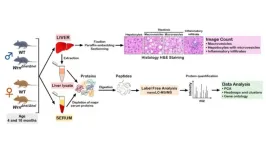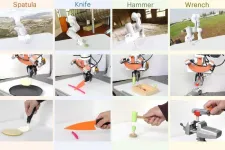(Press-News.org) In disease research, it’s important to know gene expression and where in a tissue the expression is happening, but marrying the two sets of information can be challenging.
“Single-cell technologies, especially in the emerging field of spatial transcriptomics, help scientists see where in a tissue the genes are turned on or off. It combines information about gene activity with the exact locations within the disease tissues,” explains Fan Zhang, PhD, assistant professor of medicine with a secondary appointment in the Department of Biomedical Informatics at the University of Colorado School of Medicine.
“This is really valuable because it lets physicians and researchers see not just which genes are active, but also where they are active, which can give key insights into how different cells behave and interact in diseased conditions,” she continues.
Effectively combining location and genetic information has been a tough obstacle for researchers – until now.
Zhang and her lab developed a new computational machine learning method — called Spatial Transcriptomic multi-viEW, or “STew” for short — that enables the joint analysis of spatial variation and gene expression changes in a scalable way that can handle large amounts of cells.
This new technology may help researchers learn more about the spatial biology behind many different diseases and lead them to better treatment therapies.
A path toward an accurate target for effective treatment
The new technology is accurate in finding significant patterns that show where specific cell activities happen, which is important for understanding how cells work and how clinical tissues are structured in diseases. Zhang’s lab has already successfully applied STew on human tissues, including human brains, skin with inflammation, and breast cancer tumors.
For Zhang, who studies inflammatory diseases using computational AI tools and translational approaches, finding a good target for treatment is often a challenge, but STew could help change that.
“With inflamed joints, for example, the genes causing inflammation could be closer to the blood vessel through interacting with mesenchymal structures, or they could be farther away, but knowing that exact location and cell-cell communication patterns helps us better understand the underlying mechanisms,” she says.
By merging spatial biology and molecular diversity, STew gives researchers a new dimension in classifying patient heterogeneity.
“If you only use gene expression to classify patients, you don’t have the full picture,” Zhang says. “Once you add in spatial information, you have a more comprehensive understanding.”
“We expect STew to be effective in uncovering critical molecular and cellular signals in various clinical conditions, like different types of tumors and autoimmune disorders, opening new avenues for dysregulated immune pathways for therapeutic intervention for theses disease,” she continues.
A novel software-driven route to empowering collaboration
There’s another perk that comes with the development of STew: collaboration. Scientific discoveries often benefit from experts from different fields working together.
Because STew has a wide application, Zhang says the software will bring researchers together in new and exciting ways that will ultimately benefit the field of medicine and offer promise to patients in need of treatments.
“We want to encourage researchers across specialties, skillsets, and even departments, to collaborate in ways that they previously might not have been able to do,” Zhang says. “We can accomplish more together, so it’s important to boost data-driven and AI tool-motivated collaboration in a way that is meaningful.”
END
CU researchers develop novel software that combines gene activity and tissue location to decode disease mechanisms
A new computational machine learning method developed by CU computational biologist Fan Zhang, PhD, and her lab can help researchers discover spatial patterns of gene expression in diseased tissue.
2024-06-03
ELSE PRESS RELEASES FROM THIS DATE:
Screening for prostate cancer with first-line MRI less cost-effective than first-line PSA testing
2024-06-03
Embargoed for release until 5:00 p.m. ET on Monday 3 June 2024
Annals of Internal Medicine Tip Sheet
@Annalsofim
Below please find summaries of new articles that will be published in the next issue of Annals of Internal Medicine. The summaries are not intended to substitute for the full articles as a source of information. This information is under strict embargo and by taking it into possession, media representatives are committing to the terms of the embargo not only on their ...
ACP recommends AI tech should augment physician decision-making, not replace it
2024-06-03
ACP Recommends AI Tech Should Augment Physician Decision-Making, Not Replace It
WASHINGTON, June 4, 2024—The use of artificial intelligence (AI) in clinical health care has the potential to transform health care delivery but it should not replace physician decision-making, says the American College of Physicians (ACP) in a new policy paper published today. “Artificial Intelligence in the Provision of Health Care,” published in the Annals of Internal Medicine, offers recommendations on the ethical, scientific, and clinical components of ...
YALE NEWS: Mapping the seafloor sediment superhighway
2024-06-03
New Haven, Conn. — A new scientific model is giving researchers an unprecedented, global look at the activities of clams, worms, and other invertebrate animals that burrow at the bottom of the ocean.
And what they find may offer new insights into how these mud-churning species affect ocean chemistry, carbon sequestration, and the ability of marine life to thrive globally.
Scientists have long debated the role of “bioturbation” — the excavation and stirring up of seafloor sediments caused by these species. Part of the challenge has come from trying to understand how the interactions between these animals and their surroundings influence bioturbation patterns ...
Research optimizes biological control of pest that severely damages soybean crops
2024-06-03
An article published in the journal Insects determines with precision the dispersal range of a type of wasp that neutralizes the Brown stink bug, Euschistus heros, a major soybean pest in Brazil and highly resistant to chemical insecticides. The solution discussed by the authors is Telenomus podisi, a parasitoid micro wasp first described by American entomologist William Harris Ashmead in 1893.
Parasitoids are small insects whose immature stages develop either within or attached to the outside of other insects. They ...
Traffic speeds decrease when bike lane is present
2024-06-03
Rutgers University–New Brunswick researchers conducting a study at a high-traffic intersection in a Jersey Shore town have found that the installation of a bike lane along the road approaching the convergence reduced driving speeds.
As many traffic analyses have identified speeding as a contributing factor in a majority of crashes, inducing such a “traffic calming” effect with a bike lane could enhance road safety and decrease the risk and severity of crashes, the researchers said. The research was published in The Journal of Urban Mobility.
“We are giving you more evidence that bike lanes save lives,” said Hannah Younes, a lead author of the study and a postdoctoral ...
Proteomics uncover sexual dimorphism and immune changes in aging mice with Werner syndrome
2024-06-03
“Proteomics analysis at different ages allows us to follow the progressive biological alterations (including histological fat accumulation) in the liver according to age and/or the Wrn genotype.”
BUFFALO, NY- June 3, 2024 – A new research paper was published on the cover of Aging (listed by MEDLINE/PubMed as "Aging (Albany NY)" and "Aging-US" by Web of Science) Volume 16, Issue 10, entitled, “Integrated liver and serum proteomics uncover sexual dimorphism and alteration of several immune response proteins in an aging Werner syndrome mouse model.”
Werner syndrome (WS) is a ...
A technique for more effective multipurpose robots
2024-06-03
CAMBRIDGE, MA – Let’s say you want to train a robot so it understands how to use tools and can then quickly learn to make repairs around your house with a hammer, wrench, and screwdriver. To do that, you would need an enormous amount of data demonstrating tool use.
Existing robotic datasets vary widely in modality — some include color images while others are composed of tactile imprints, for instance. Data could also be collected in different domains, like simulation or human demos. And each dataset ...
Oral nucleoside antiviral is progressing toward future pandemic preparedness
2024-06-03
May 23, 2024
Obeldesivir (GS-5245), a novel investigational small molecule oral antiviral, represents a new tool in the ongoing effort to prepare for future pandemics.
Several researchers at the University of North Carolina at Chapel Hill’s Gillings School of Global Public Health are co-authors of a new study published online May 22 by the journal Science Translational Medicine.
The study shares findings from an academic-corporate partnership between biopharmaceutical company Gilead Sciences and the Sheahan ...
Shape and depth of ocean floor profoundly influence how carbon is stored there
2024-06-03
Key takeaways
The movement of carbon between the atmosphere, oceans and continents — or carbon cycle — regulates Earth’s climate, with the ocean playing a major role in carbon sequestration.
A new study finds that the shape and depth of the ocean floor explain up to 50% of the changes in depth at which carbon has been sequestered there over the past 80 million years.
While these changes have been previously attributed to other causes, the new finding could inform ongoing efforts to combat climate change through marine carbon sequestration.
The movement of carbon between the atmosphere, oceans and continents — the carbon ...
Airplane noise exposure may increase risk of chronic disease
2024-06-03
FOR IMMEDIATE RELEASE
Monday, June 3, 2024
Contact:
Jillian McKoy, jpmckoy@bu.edu
Michael Saunders, msaunder@bu.edu
##
Airplane Noise Exposure May Increase Risk of Chronic Disease
A new study found that people who were exposed to higher levels of noise from aircraft were more likely to have a higher body mass index, an indicator for obesity that can lead to stroke or hypertension. The findings highlight how the environment—and environmental injustices—can shape health outcomes.
Research has shown that noise from airplanes and helicopters flying overhead are far more bothersome to people than noise from other modes of transportation, ...
LAST 30 PRESS RELEASES:
New prostate cancer trial seeks to reduce toxicity without sacrificing efficacy
Geometry shapes life
A CRISPR screen reveals many previously unrecognized genes required for brain development and a new neurodevelopmental disorder
Hot flush treatment has anti-breast cancer activity, study finds
Securing AI systems against growing cybersecurity threats
Longest observation of an active solar region
Why nail-biting, procrastination and other self-sabotaging behaviors are rooted in survival instincts
Regional variations in mechanical properties of porcine leptomeninges
Artificial empathy in therapy and healthcare: advancements in interpersonal interaction technologies
Why some brains switch gears more efficiently than others
UVA’s Jundong Li wins ICDM’S 2025 Tao Li Award for data mining, machine learning
UVA’s low-power, high-performance computer power player Mircea Stan earns National Academy of Inventors fellowship
Not playing by the rules: USU researcher explores filamentous algae dynamics in rivers
Do our body clocks influence our risk of dementia?
Anthropologists offer new evidence of bipedalism in long-debated fossil discovery
Safer receipt paper from wood
Dosage-sensitive genes suggest no whole-genome duplications in ancestral angiosperm
First ancient human herpesvirus genomes document their deep history with humans
Why Some Bacteria Survive Antibiotics and How to Stop Them - New study reveals that bacteria can survive antibiotic treatment through two fundamentally different “shutdown modes”
UCLA study links scar healing to dangerous placenta condition
CHANGE-seq-BE finds off-target changes in the genome from base editors
The Journal of Nuclear Medicine Ahead-of-Print Tip Sheet: January 2, 2026
Delayed or absent first dose of measles, mumps, and rubella vaccination
Trends in US preterm birth rates by household income and race and ethnicity
Study identifies potential biomarker linked to progression and brain inflammation in multiple sclerosis
Many mothers in Norway do not show up for postnatal check-ups
Researchers want to find out why quick clay is so unstable
Superradiant spins show teamwork at the quantum scale
Cleveland Clinic Research links tumor bacteria to immunotherapy resistance in head and neck cancer
First Editorial of 2026: Resisting AI slop
[Press-News.org] CU researchers develop novel software that combines gene activity and tissue location to decode disease mechanismsA new computational machine learning method developed by CU computational biologist Fan Zhang, PhD, and her lab can help researchers discover spatial patterns of gene expression in diseased tissue.

